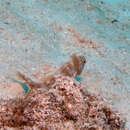en
names in breadcrumbs


Diagnosis: The fin-ray count of D-IX,12 A-III,12 and Pect-12 indicates the razorfish genus Xyrichtys. One other regional labrid, Halichoeres cyanocephalus, shares the median-fin ray count, but has 13 pectoral-fin rays and a clearly different body shape. The three Caribbean razorfishes, X. martinicensis, X. novacula, and X. splendens, share fin-ray counts and the larvae can overlap in appearance. The species become distinct as they develop juvenile markings: X. splendens recruits are recognized by a pattern of bars and reticulations and the first two dorsal fin spines are extended. The extended dorsal fin spines persist until juveniles reach about 35 mm SL.
Analogues: Larval Xyrichtys have no melanophores and often markedly-narrowed eyes. The absence of external melanophores is shared with larval Doratonotus megalepis, which are distinctly wider-bodied and have large round eyes. All other regional labrid and scarid larvae have melanophores. X. splendens recruits have a a complex pattern of bars and reticulations and the extended first two dorsal fin spines while X. martinicensis recruits have a lateral stripe from the eye to the tail and no extension of the dorsal fin spines and X. novacula recruits have a lateral stripe that is broken up into discrete patches or spots.
Description: Body thin and long with a markedly narrowed eye (pre-transitional) to large and round (recruits) with a pointed snout and a terminal small mouth. Pectoral fins medium, reach to vent. Pelvic fins stubs. Dorsal and anal-fin bases long, caudal peduncle short. There are no surface or internal melanophores. Transitional recruits show a pattern of bars and reticulations and the first two dorsal-fin spines are extended.